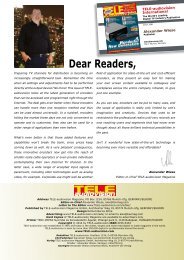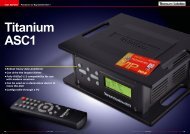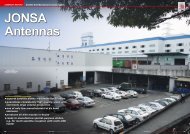eng TELE-audiovision 1411
The World’s Largest Digital TV Trade Magazine
The World’s Largest Digital TV Trade Magazine
Create successful ePaper yourself
Turn your PDF publications into a flip-book with our unique Google optimized e-Paper software.
24<br />
Testing Receiver on The Go<br />
24. A genuine sensation delivered by RT-RK: a receiver tester for on-the-go!<br />
The system contains all components required for on-site receiver testing, no<br />
matter where you are. The AV150 is mainly geared towards field staff of large<br />
TV providers. Customers are no longer required to send in a faulty receiver<br />
for inspection and wait for the repaired box or a replacement product. “As<br />
it is often the case, the receiver is not to blame for the problem, but simply<br />
incorrect user inputs,” says Vukota Pekovic. It is much more convenient<br />
for the customer – as well as more efficient for the provider – to look at the<br />
problem right at the customer’s home. “Using the AV150 a service technician<br />
is able to test all receiver functions and find an optimum solution for technical<br />
troubles.”<br />
25<br />
Receiver Network Testing<br />
25. Even though this system is not yet in actual use, RT-RK has completed its<br />
development and is ready for launching it: Content providers are given a tool that<br />
allows them to monitor all functions of their channels in real-time. The system<br />
uses receivers provided by the content company and installed at the customers’<br />
end. Since these days most receivers are connected to the Internet, RT-RK uses<br />
this Internet connection as return channel for evaluating a range of metadata sent<br />
by the receiver. In particular, this involves the currently received transponder<br />
and channel of the receiver as well as its signal str<strong>eng</strong>th. With the help of the<br />
so-called INSIGHT software from RT-RK content providers can then look at a<br />
graphical presentation of the current functions of their network. Seen here is a<br />
simulation for the terrestrial DVB-T network in Serbia. Five receivers on the wall<br />
simulate five different locations across the country and the displays show the<br />
current reception quality: Yellow stands for OK, red indicates a weak signal. If<br />
a content provider uses metadata from thousands of receivers instead of five, it<br />
is possible to gain an exact insight into the current live state of its broadcasting<br />
network.<br />
126 <strong>TELE</strong>-<strong>audiovision</strong> International — The World‘s Leading Digital TV Industry Publication — 11-12/2014 — www.<strong>TELE</strong>-<strong>audiovision</strong>.com

















